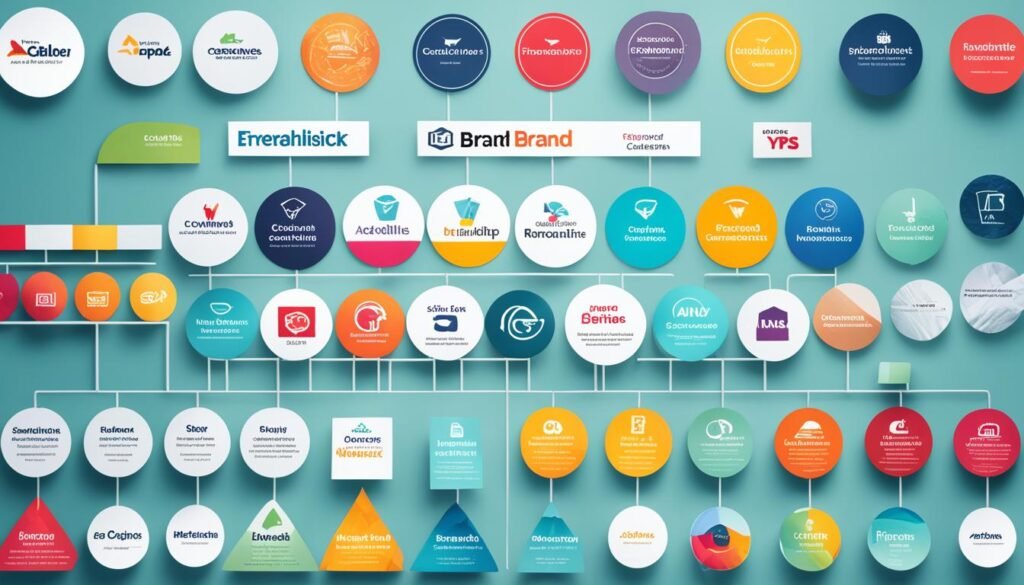Brand architecture is a crucial element for business growth, providing the framework and structure necessary to build a successful brand portfolio. It encompasses the organizational strategy that determines how a company’s brands, sub-brands, and products or services are organized and related to each other. A well-designed brand architecture ensures clarity and consistency in messaging, enhances brand equity, and fosters customer loyalty.
Without a solid brand architecture, businesses may face challenges in effectively communicating their brand’s value and differentiation to consumers. This can lead to confusion in the market and dilution of the brand’s impact. By establishing a strategic brand architecture, companies can align their brand portfolio with their overall business strategy and optimize their market presence.
Key Takeaways:
- An effective brand architecture strategy is essential for business growth and building brand equity.
- Brand architecture defines how brands, sub-brands, and products/services are organized within a company.
- Types of brand architectures include branded house, house of brands, endorsed brands, and hybrid brands.
- A strong brand architecture enhances brand messaging consistency and fosters stronger emotional connections with customers.
- Building a strong brand architecture requires conducting a brand audit, defining brand positioning, establishing a brand hierarchy, and implementing clear brand guidelines.
What is Brand Architecture?
Brand architecture refers to the strategic arrangement and organization of a company’s brands within its portfolio. It serves as an organizational framework to create clarity, consistency, and a strong brand identity. By defining the relationships between the corporate brand, product brands, and sub-brands, brand architecture helps businesses effectively manage and communicate their brand portfolio to consumers, stakeholders, and employees.
An effective brand architecture not only provides structure but also informs the development of brand identity, style guide, and brand story. It ensures that all brands within the portfolio are aligned and convey a unified message to the target audience. With a well-designed brand architecture, companies can establish a strong brand messaging consistency and enhance their brand equity.
Brand architecture is like the blueprint that guides a company in organizing and presenting its brands to the world.
Having a clear brand architecture is crucial in establishing a robust brand identity. It sets the stage for businesses to create a strong and recognizable presence in the market, which ultimately drives brand growth. By strategically organizing their brands, companies can effectively leverage their existing brand equity and expand their customer base.
Implementing a strong brand architecture also improves marketing efficiency. Companies can streamline their marketing efforts by clearly defining the positioning and messaging for each brand within their portfolio. This results in more targeted and effective communication, resonating with the intended audience and ultimately increasing brand awareness.
Benefits of Brand Architecture
Effective brand architecture provides a range of benefits for businesses:
- Clarity and Consistency: Brand architecture ensures a clear and consistent presentation of brands and sub-brands.
- Brand Equity: A well-designed brand architecture enhances brand equity by strengthening the overall brand image.
- Customer Loyalty: A clear brand architecture fosters customer loyalty by creating a cohesive and trustworthy brand experience.
- Efficient Resource Allocation: Brand architecture allows for effective resource allocation, enabling companies to optimize their investments in branding and marketing.
By building a solid brand architecture, businesses can set the foundation for long-term success and drive sustainable growth.
| Benefits | Brand Architecture |
|---|---|
| Clarity and Consistency | Ensures clear and consistent brand presentation |
| Brand Equity | Strengthens overall brand image and value |
| Customer Loyalty | Fosters loyalty through cohesive brand experiences |
| Efficient Resource Allocation | Optimizes investments in branding and marketing |
Types of Brand Architecture

When it comes to brand architecture, there are several models that companies can adopt to organize their brands and create a cohesive brand portfolio. Each model offers its own unique advantages and considerations.
Branded House: In this model, multiple house brands are consolidated under a single master brand. The parent company is the driving force behind all brand activities, and the individual brands benefit from the association with the master brand. This approach provides a strong and unified brand identity, allowing for greater brand recognition and customer loyalty.
House of Brands: With this architecture, the parent company operates as a brand umbrella, housing multiple independent brands. Each brand has its own unique identity, positioning, and target market. This model allows for greater flexibility and allows companies to cater to different customer segments without diluting individual brand equity.
Endorsed Brands: In an endorsed brands model, the parent company lends its brand name and credibility to individual brands within its portfolio. The parent brand provides a stamp of approval and adds value and trust to the endorsed brands. This approach can be particularly effective for entering new markets or industries.
Hybrid Brands: Hybrid brands combine elements of multiple brand architecture models to suit a company’s specific needs. This approach offers the benefits of customization and flexibility. Companies can adapt their brand structure based on different product lines, markets, or audiences. It allows for a balance between centralization and decentralization, ensuring consistency while accommodating brand diversification.
Understanding the different types of brand architecture models is crucial for companies to determine the most suitable approach for their brand portfolio. By carefully selecting the right model, companies can effectively manage their brands, maximize brand equity, and achieve long-term success.
Benefits of a Strong Brand Architecture

A strong brand architecture offers numerous benefits that contribute to the overall success of a business. By implementing an effective brand architecture strategy, companies can reap the advantages of brand messaging consistency, enhanced brand equity, and increased brand awareness.
One of the key benefits of a strong brand architecture is ensuring brand messaging consistency. With a well-defined brand architecture in place, companies can align their brand messaging with their core values, mission, and vision. This consistency helps to build a strong and cohesive brand identity, thereby reinforcing customer trust and loyalty.
A well-designed brand architecture also strengthens brand equity. Brand equity refers to the value that a brand carries within the minds of consumers. When a brand architecture is strategically developed to create a clear and unified identity, it enhances the overall brand equity. This increased brand equity enables companies to command premium prices, attract new customers, and differentiate themselves from competitors.
In addition to brand messaging consistency and equity, a strong brand architecture also fosters greater brand awareness. By strategically organizing the brand portfolio and establishing clear relationships between different brands and sub-brands, companies can ensure that each brand receives the appropriate visibility and recognition. This increased brand awareness translates into more opportunities to engage with customers and expand market reach.
Furthermore, a strong brand architecture allows for the effective utilization of existing brand equity for new products or services. By leveraging the strong brand identity and recognition of an established brand, companies can expedite market entry and reduce the risk of brand dilution. This means that new offerings can benefit from the reputation and customer loyalty that have already been established by the parent brand.
| Benefits of a Strong Brand Architecture |
|---|
| Enhances brand messaging consistency |
| Strengthens brand equity |
| Increases brand awareness |
| Allows for effective utilization of existing brand equity for new products or services |
Steps to Build a Strong Brand Architecture
Building a strong brand architecture requires careful planning and execution. Follow these essential steps to establish a solid foundation for your brand portfolio:
1. Conduct a Brand Audit
A brand audit is a comprehensive assessment of your current brand portfolio. It involves analyzing your existing brands, sub-brands, and products/services to gain insights about their performance, positioning, and relevance. A brand audit provides valuable data that informs your brand architecture strategy.
2. Define Brand Positioning
Defining brand positioning is a crucial step in building a strong brand architecture. It involves identifying the unique selling propositions and target audience for each brand within your portfolio. By clearly defining the positioning for each brand, you can ensure consistency and effectiveness in your brand messaging and communication.
3. Establish Brand Hierarchy
Establishing a brand hierarchy is essential for creating clarity and maintaining order within your brand portfolio. It involves clearly defining the relationships between your brands, sub-brands, and products/services. A well-defined brand hierarchy helps consumers and stakeholders understand the different offerings and their associations, enabling better brand management and customer engagement.
4. Design Visual and Verbal Identity
A consistent visual and verbal identity is crucial for building a strong brand architecture. It involves creating a cohesive look and feel across all brands within your portfolio. This includes designing logos, color schemes, typography, and crafting a brand story that resonates with your target audience. A visually appealing and cohesive brand identity enhances brand recognition and strengthens brand equity.
5. Implement Clear Brand Guidelines
To ensure consistency in brand communication, it’s important to implement clear brand guidelines. These guidelines define the rules and standards for using your brand assets, including your logo, visuals, and messaging. Clear brand guidelines ensure that all stakeholders adhere to the established brand identity and maintain a cohesive brand image.
By following these steps, you can build a strong brand architecture that drives brand growth, enhances brand equity, and fosters stronger customer connections.
Common Mistakes to Avoid in Brand Architecture

When it comes to developing a brand architecture, there are several common mistakes that companies should steer clear of. By avoiding these pitfalls, businesses can ensure a more effective and successful brand strategy.
Lack of Consistency
A lack of consistency in branding can significantly impact a company’s brand architecture. When brands within the portfolio fail to have a consistent look and feel, it can dilute the brand’s impact and confuse consumers. Consistency is vital in building brand recognition and establishing a strong brand identity.
Ignoring Customer Feedback
Customer feedback is a valuable resource for businesses. Ignoring customer feedback in the development of brand architecture can lead to missed opportunities for improvement and hinder brand growth. Companies should actively listen to customer feedback and use it to refine and enhance their brand strategy.
“Listening to your customers and incorporating their feedback is essential in building a successful brand architecture. By understanding their needs and preferences, you can create a more customer-centric brand that resonates with your target audience.”
Overcomplicating Brand Structure
Overcomplicating the brand structure can have detrimental effects on a company’s brand architecture. When the structure is overly complex, it can create confusion both internally and externally. A convoluted brand structure makes it challenging for employees to understand and communicate the brand effectively and can confuse customers as well.
It’s crucial to strike a balance between simplicity and relevance when designing a brand architecture that meets business needs. Taking a streamlined approach that aligns with company values and resonates with customers is key to building a successful brand architecture.
| Common Mistakes | Effects |
|---|---|
| Lack of Consistency | Diluted brand impact and confusion among consumers |
| Ignoring Customer Feedback | Missed opportunities for improvement and hindered brand growth |
| Overcomplicating Brand Structure | Internal and external confusion |
Tools and Resources for Building Brand Architecture

When it comes to building an effective brand architecture, utilizing tools and resources can greatly facilitate the process. Here are some valuable resources that can assist businesses in developing a strong brand architecture:
-
Branding Agencies
Branding agencies offer strategic guidance, creative design, and expertise in brand management. They can assist businesses in developing a comprehensive brand architecture that aligns with their overall goals and objectives. Whether it’s defining brand hierarchy, crafting brand guidelines, or creating a brand story, branding agencies provide the necessary expertise to ensure a successful brand architecture implementation.
-
Branding Workshops
Branding workshops provide hands-on guidance for businesses looking to develop a strong brand architecture. These workshops allow participants to engage in interactive sessions where they can learn about various brand architecture models, case studies, and best practices. By participating in these workshops, businesses can gain valuable insights and practical knowledge that can be applied to their own brand architecture strategies.
-
Brand Management Tools
Various brand management tools are available to assist businesses in creating and implementing a cohesive brand strategy. These tools facilitate the organization and management of brand assets, including brand guidelines, visual identity elements, and brand messaging. They streamline brand communication processes, ensure consistency across all brand touchpoints, and simplify the management of complex brand architectures.
By leveraging the expertise of branding agencies, participating in branding workshops, and utilizing brand management tools, businesses can navigate the complexities of brand architecture and ensure its successful implementation. These resources provide the necessary guidance and support to establish a strong brand architecture that drives business growth and strengthens brand equity.
Brand Architecture Decision-Making

When it comes to making decisions about brand architecture, companies need to carefully consider several key factors to ensure their long-term success. These factors include their long-term vision, target market, brand credibility, and financial investment.
Firstly, companies must have a clear understanding of their long-term vision. This involves defining their goals, aspirations, and the direction in which they want the brand to grow. By considering their long-term vision, companies can make informed decisions that align with their overall business strategy.
Secondly, understanding the target market is essential. It’s important for companies to identify their target audience and understand their needs, preferences, and expectations. By having a deep understanding of their target market, companies can tailor their brand architecture to effectively communicate the value of their offerings to customers.
Brand credibility is another critical factor to consider. Companies need to assess the strength and credibility of their brand in the marketplace. This involves evaluating consumer perceptions, brand reputation, and the trust customers have in the brand. By considering brand credibility, companies can ensure that their brand architecture builds upon a solid foundation of trust and authenticity.
Lastly, the financial investment required to support multiple brands should be carefully evaluated. Developing and maintaining multiple brands can be costly, requiring dedicated resources and financial commitments. It’s important for companies to assess whether they have the necessary financial investment to effectively support multiple brands within their brand architecture.
In conclusion, when making decisions about brand architecture, companies must consider their long-term vision, target market, brand credibility, and financial investment. By taking these factors into account, companies can make strategic decisions that align with their business goals and effectively communicate the value of their offerings to customers.
Choosing the Right Model for Your Brand Architecture

When it comes to brand architecture, selecting the right model is crucial for companies aiming to effectively communicate their brand offerings. By evaluating the various brand architecture models available, businesses can determine which one aligns best with their unique needs and objectives. Let’s explore some popular models:
Branded House
The branded house model is an ideal fit for companies seeking to leverage a strong master brand across all their offerings. Under this architecture, the master brand serves as the umbrella that encompasses and unifies all the sub-brands and products. This approach allows for consistent brand messaging and emphasizes the brand’s overall identity.
Sub-Brand
Sub-brands provide businesses with the opportunity to differentiate while maintaining a strong association with the master brand. This model allows companies to create a portfolio of brands, each with its own unique value proposition. Sub-brands benefit from the credibility and recognition of the master brand, establishing a seamless connection between the two.
Endorsed Brand
Endorsed brands rely on the reputation and credibility of the parent brand. This model is suitable for businesses that want to establish independent brands while leveraging the established brand equity. The parent brand endorses the sub-brands, providing an added layer of trust and enhancing their market appeal.
House of Brands
A house of brands architecture allows for independent branding and targeting of distinct market segments. Each brand under the parent company operates as a separate entity, with its own brand identity, messaging, and target audience. This model grants businesses the autonomy to develop unique strategies for each brand within their portfolio.
Hybrid Brand
The hybrid brand architecture combines elements of multiple models, providing businesses with flexibility and customization. This approach allows companies to choose different models for specific brand segments or product categories, tailoring their brand strategies to suit individual market needs. Hybrid brand architecture enables organizations to achieve the best of both worlds.
Choosing the right brand architecture model requires careful consideration of the company’s goals, offerings, and target audience. It is essential to determine which model aligns most effectively with the business’s overall strategy, ensuring optimal brand positioning and long-term growth.
Importance of Effective Brand Architecture

Effective brand architecture plays a critical role in the differentiation, relevance, positioning, and growth of a company’s brands in the market. When brands have a well-designed architectural framework, they have a competitive edge by standing out from their rivals. This strategic arrangement enables businesses to effectively communicate the unique value of their offerings, capturing the attention and loyalty of their target audience.
By implementing a comprehensive brand architecture strategy, companies ensure that their brands remain relevant to the ever-evolving customer needs. This relevance helps build a strong connection with consumers, fostering trust, and increasing brand affinity. Consistency in brand identity and messaging across various channels and touchpoints further strengthens the brand’s positioning in the market.
Furthermore, effective brand architecture facilitates brand growth by providing the necessary structure and framework to expand offerings and enter new markets. A clear and cohesive brand identity gives businesses the confidence to introduce new products or services under the same architectural umbrella, leveraging the existing brand equity for a competitive advantage.
This image visualizes the concept of brand growth, emphasizing the importance of effective brand architecture as the foundation for business success.
Through differentiation, relevance, positioning, and brand growth, companies can capitalize on their unique strengths and unlock new opportunities in the market. A well-executed brand architecture strategy ensures that every brand within a company’s portfolio has a purpose and a distinct identity, contributing to overall business growth and success.
The Role of Brand Architecture in Business Growth

Brand architecture plays a significant role in business growth by enhancing brand equity, fostering customer loyalty, and improving marketing efficiency. A well-defined brand architecture enables companies to leverage brand equity across their portfolio, increasing brand recognition and attracting new customers. It also facilitates cross-promotion, brand awareness, and strategic mergers and acquisitions.
By developing a clear and effective brand architecture, companies can position themselves for long-term growth and success.
Brand equity refers to the value and perception that consumers associate with a brand. A strong brand architecture enhances brand equity by creating a cohesive brand identity and consistent brand messaging. This can lead to increased customer trust, loyalty, and willingness to pay a premium for branded products or services.
Customer loyalty is crucial for business growth as it drives repeat purchases and recommendations. A well-designed brand architecture helps build customer loyalty by delivering consistent brand experiences across different touchpoints. When customers have a positive experience with one brand within a portfolio, they are more likely to trust and engage with other brands owned by the same company.
Marketing efficiency is improved through effective brand architecture by optimizing resource allocation, messaging, and targeting. With a clear brand architecture, companies can identify and focus their marketing efforts on specific customer segments or product categories. This targeted approach allows for more efficient use of marketing budgets and resources, resulting in higher returns on investment.
Strategic mergers and acquisitions are facilitated by a well-defined brand architecture. Companies with a strong brand architecture can seamlessly integrate acquired brands into their portfolio, leveraging the existing brand equity and customer loyalty. This not only expands their market presence but also enables them to diversify their offerings and reach new customer segments.
In summary, brand architecture plays a critical role in business growth by enhancing brand equity, fostering customer loyalty, improving marketing efficiency, and enabling strategic mergers and acquisitions. To unlock the full potential of these benefits, companies should invest in developing a clear and effective brand architecture that aligns with their business goals and target audience.
Also Read: Modern Furniture Trends And Styles For Your Home
Conclusion
A robust brand architecture is crucial for business growth and success. It provides the necessary structure and clarity to effectively organize a company’s brand portfolio. By choosing the right brand architecture model and following a strategic approach, companies can develop a strong brand identity and build brand equity.
A well-defined brand architecture sets the foundation for better brand equity, increased customer loyalty, and improved marketing effectiveness. It allows businesses to leverage the full potential of their brands, attracting new customers and driving long-term growth. With a clear brand architecture, companies can position themselves as leaders in their industry and stand out from their competitors.
By investing in a robust brand architecture, companies can create a cohesive brand portfolio that resonates with customers and drives business growth. A strong brand architecture ensures that each brand within the portfolio aligns with the overall brand strategy, fostering consistency and clarity in messaging. It enables companies to manage and communicate their brand portfolio effectively, maximizing the value and impact of each brand.
FAQs
Q: What is brand architecture and why is it essential for business growth?
A: Brand architecture refers to the hierarchical structure of brands within a company. It outlines how different brands and sub-brands are organized and related to each other. A clear brand architecture is vital for business growth as it helps customers understand the brand’s offerings and the relationship between different products and services.
Q: What are the different types of brand architecture?
A: There are several types of brand architecture, including branded house architecture, house of brands structure, endorsed brand architecture, hybrid architecture, and umbrella brand. Each type has its own advantages and is suitable for different business strategies.
Q: How can brand architecture help in creating a cohesive brand strategy?
A: Brand architecture provides a framework for developing a clear and consistent brand strategy. By defining the relationship between different brands and products, brand architecture ensures that all elements of the brand are aligned and work towards the same goals.
Q: Can you provide some examples of brand architecture to illustrate how it works?
A: Sure, some examples of brand architecture include Procter & Gamble, which uses a house of brands structure with multiple sub-brands like Tide, Pampers, and Gillette. On the other hand, Coca-Cola uses a branded house architecture where all products are under the main Coca-Cola brand.
Q: What is the main goal of developing a brand architecture framework for your business?
A: The main goal of creating a brand architecture framework is to ensure that all brand elements, from brand names to logos, are aligned with the overall brand strategy. It helps in creating a consistent and distinct brand identity that resonates with customers.
Q: How does brand architecture contribute to brand loyalty and managing your brand effectively?
A: A well-defined brand architecture can help in building brand loyalty as customers can easily identify and connect with different products and services offered by the brand. Managing your brand becomes easier when the brand architecture is clear and consistent across all touchpoints.
Q: What is the right brand architecture strategy for a business looking to expand its brand portfolio?
A: The right brand architecture strategy depends on the business goals and the relationships between different products and services. It’s essential to assess whether a branded house approach, a house of brands structure, or a hybrid architecture would best support the brand’s growth and communication objectives.





